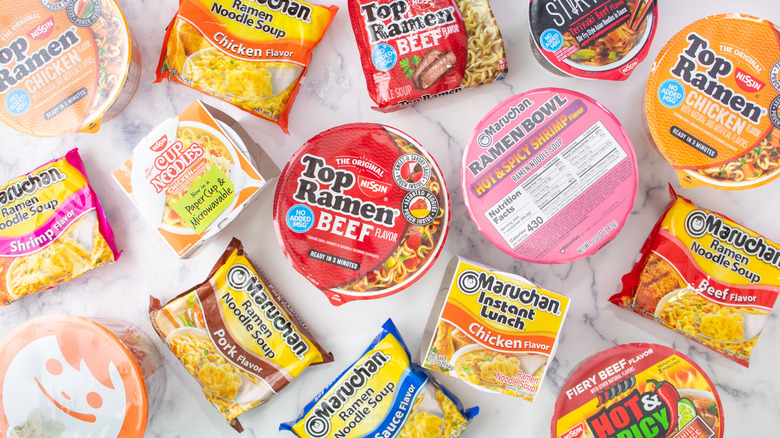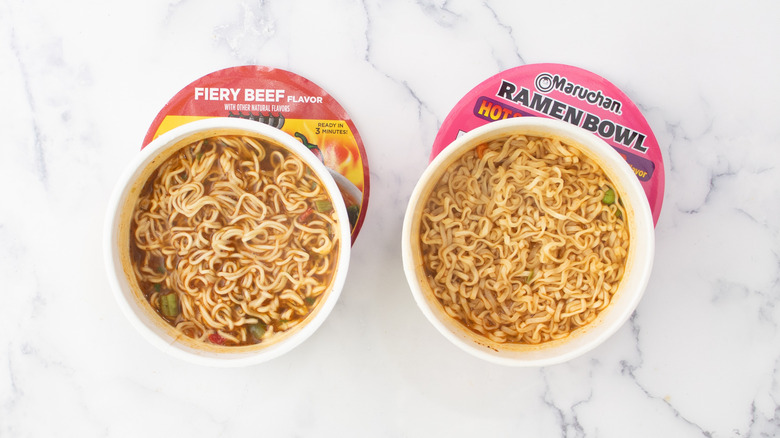Nissin Vs Maruchan: Which Is The Superior Instant Ramen Brand?

 Patterson Watkins / Chowhound
Patterson Watkins / ChowhoundNissin and Maruchan are giants in the ramen world. Both brands take up the bulk of the retail ramen noodle options. Momofuku Ando, founder of Nissin, created his company in 1958. Post-WWII Japanese food shortages inspired Ando to create instant ramen. With Nissin’s domestic growth and popularity, expansion into the global market followed shortly thereafter, bringing an instant ramen base of operations to California in 1972. Maruchan, meanwhile, began as a Japanese frozen fish distributor and expanded into ramen production in 1961. In 1977, Maruchan also launched stateside and has been nipping (or slurping) at the heels of Nissin for the decades since. The ramen market is mighty, with Americans averaging four billion ramen servings per year.
In the spirit of competition, I’m going to put these two ramen behemoths to the test, pitting cup versus cup, bowl versus bowl, and packet versus packet to see which brand, Nissin or Maruchan, reigns supreme. I used cost, availability, overall flavor, and noodle quality as my comparison evaulators. Prices may vary based on location.
Packet ramen: Nissin’s Top Ramen vs. Maruchan’s Ramen Noodle Soup

I selected a core flavor (beef) from each brand to level the playing field and start off this battle on even footing. Maruchan boasts 14 varieties of packet ramen versus Nissin’s core five with each having robust SKUs available at most grocery stores; beef, shrimp, and chicken being the most represented.
You’ll find no shortage of packet ramen, either, available in single packs or bulk, Nissin or Maruchan. As mentioned above, the core flavors are typically well represented, with some of the fancier packets, Nissin or Maruchan’s Chili Flavor, for example, available online or at Asian markets.
These packets are notoriously affordable, the Beef Flavor packets we purchased both came in under $1. Nissin’s packet cost us $.79, while Maruchan’s packet cost $.69. Both are readily available, with an expansive inventory of options. But Maruchan Ramen Noodle Soup wins this category by being just slightly less expensive than Nissin’s Top Ramen.
Packet ramen flavor and noodle quality

Nissin’s Top Ramen had a light to moderate salt balance with a slightly silky richness to the broth. The beef element was noticeably muted and that flavor only lightly adhered itself to the noodles. The Top Ramen noodles were loose ringlet coils with a wheaty appearance and flavor (unfortunately, with a hint of cardboard). The texture was soft but slurp-worthy and only started to really break down after several minutes in the hot broth.
Maruchan’s Ramen Noodle Soup was robustly beefy with a moderate to high salt balance. That moderate to high salt balance actually enhanced the flavor adherence to the noodles, accented by an almost buttery element to the broth. The noodles were tight and curly, with a playful spring. That springiness made slurping fun (and a little messy) with a pleasant, toothsome bite.
Maruchan’s Ramen Noodle Soup wins this category by a landslide. The advertised flavor (beef) was pronounced, the salt balance was on point, and the noodles were delicious.
Ramen in a cup: Nissin’s Cup Noodles vs. Maruchan’s Instant Lunch

This is a juggernaut category for two juggernaut ramen companies: The cup battle. Nissin’s founder, the man who brought us instant ramen, is also responsible for inventing these convenient to-go cups (he observed soup-savoring Americans using mugs as serving vessels and voilà, cup noodles). Maruchan launched its version shortly after.
Nissin boasts six Cup Noodles in its to-go ramen category, with chicken being the most easily sourced (beef and shrimp coming in at a close second). Maruchan has an overwhelming 14 cups in its catalog, with, again, the standard flavors (chicken, beef, and shrimp) being well-stocked options. Both companies offer single-serve as well as bulk case packs. The flavors outside of the tried-and-true (and less likely to be at your local grocer) are available in mass online. For this ramen in a cup testing phase, I opted for both brand’s chicken flavors.
Maruchan continues to be the more economical option, with its $.69 price point. The Nissin Cup Noodle I found costs $1.19. With Maruchan’s vast inventory of cups and flavors, you’re more likely to find variety and abundance. Along with its more affordable prices, Maruchan wins this round.
Ramen in a cup flavor & noodle quality

Maruchan’s Instant Lunch had a noticeably hearty tablespoon of dried vegetables (peas, corn, carrots) sitting atop the noodles. When steeped in the boiling water, these vegetal flavors came alive, adding a mirepoix effect to the already umami-laced broth. There was a moderate to high salt balance that really made the chicken flavor pop and seep into the noodles. The noodles were different from the packet ramen; thin and semi-flat with a looser coiling. They had a moderate bite and chew, silky feel, and almost al dente after the three-minute steep.
Nissin’s Cup Noodles went with a more herbaceous element than vegetal (very few vegetable additions) to enhance the broth’s flavor. The broth was unctuous but lacked any hearty evidence of chicken. The salt balance was low to moderate, lightly infusing the noodles and coming across almost bland in comparison to Maruchan’s cup. Nissin’s noodles were also different from its packet offerings; these were super tight, springy coils with a moderate chew. The noodles were roughly textured, almost grainy, which greatly reduced its appeal.
That means, when it comes to flavor, Maruchan wins again. The overall flavor and noodle quality was certainly superior.
Ramen spicy bowl: Nissin’s Hot & Spicy Bowl vs. Maruchan’s Ramen Bowl

These larger format bowls seem to be crafted for those who like its meals spicy as well as in response to the boon of fancier ramen restaurants. Both companies have a hearty selection of these fiery ramen bowls. Nissin chili spiked eight out of its 11 bowl options, with Maruchan having four out of its six dedicated to the heat. The non-spicy bowls adhere to the more traditional flavors, most common: beef and chicken with the occasional soy sauce or shrimp. I went the spicy route with Nissin’s Hot & Spicy Fiery Beef Ramen Bowl and Maruchan’s Hot & Spicy Shrimp Ramen Bowl for this round of judging.
The grocery store availability and stocking consistency of these bowls (both Nissin and Maruchan) seem to be a bit scattered. Nissin, having the most variety in this category, might be the brand to gravitate towards, as well as the brand with a greater combination of spicy and not-spicy. Maruchan, having the lesser bowl inventory, does have some spicy options in its cup line as well. If you are fond of a specific flavor by a specific brand, online shopping might be the better bet. As for price, these bowls are still very affordable. Maruchan’s Hot & Spicy Shrimp Ramen Bowl cost us $1.89 and Nissin’s Hot & Spicy Fiery Beef Ramen Bowl came in at $1.79. Nissin wins this round with a more affordable ramen bowl as well as a greater bowl inventory.
Ramen spicy bowl flavor & noodle quality

Nissin’s spicy beef ramen bowl comes with a trio of packets to further infuse with flavor: a seasoning packet, a dried herbs & veggie packet, and a spicy sauce packet. This bowl packs some big flavor. The broth has this roast beef and roasted mirepoix element with a zesty oil disbursement that clings well to the noodles. Moderate salt balance with heat that is more “back of the palate” and black peppery than chili, with a decent linger time. Nissin’s noodles are thin with a loose coil that steeps up soft and tender, are not very chewy, and have a tendency to break. Maruchan’s spicy shrimp ramen bowl contains two packets: a dried shrimp with veggies packet and a seasoning packet. This bowl has a zesty, vibrant, and spicy chili pepper burn (front of the palate) with moderate salt balance. The shrimp flavor is lackluster unless you happen to get a bite that contains one of the shrimp pieces. It looks as though Maruchan uses the same noodles for its bowls as the cups. Thinner, flatter noodles with a loose coil that have a moderate chew and al dente quality.
For the first time, there is a tie in the flavor department. Nissin’s spicy beef ramen bowl has the winning flavor but lacks that crave-worthy noodle integrity. Maruchan’s spicy ramen bowl is missing that consistent shrimp flavor but has the better noodles.
The winning ramen brand

After many, many rounds of ramen testing, I think there is a clear winner. While both brands are synonymous with convenience and quick, tasty meals, there could only be one. The ramen brand I selected is consistently affordable, with a price point that doesn’t hurt your wallet. It has a robust inventory of packets, cups, and bowls that ensure common grocery stores are well-stocked with its offerings. Its catalog presents consistently crave-worthy products with true to packaging flavor and a balanced sodium presence. Its noodles are well-textured, tasty, and super slurpy.
Our winning ramen brand is… drum roll… Maruchan. Nissin still warms my heart and belly by being the creator of instant ramen and Cup Noodles. It, unfortunately, has been outdone by its copycatting competition in all the places that truly count: affordability, availability, flavor, and noodle quality. On these, Maruchan reigns supreme.
Methodology
My judging criteria were based on these factors: cost, availability, overall flavor, and noodle quality. For cost and availability, I looked for ramen options that are readily available (well stocked at most grocers) and which brand has the most affordable product in that category. For flavor, I looked for ramen that tasted as advertised (shrimp-flavored ramen having a definitive shrimp flavor), had a good salt balance, and had a crave-worthy finished product. The noodles are the star of every ramen show. So, I judged whether or not the noodles were good-tasting, springy, toothsome, and overall pleasant, bite after bite.
To make sure I kept this competition fair, I stocked up on ramen products of similar merit, style, and flavor. I assessed both Nissin and Maruchan selections (online and in-store) to make sure I was sampling and testing items that were easily sourced and readily available. I listed the prices I paid for each product to determine affordability. And, for each round of sampling, I taste-tested both ramen products together to best assess their flavor and quality of noodles.










